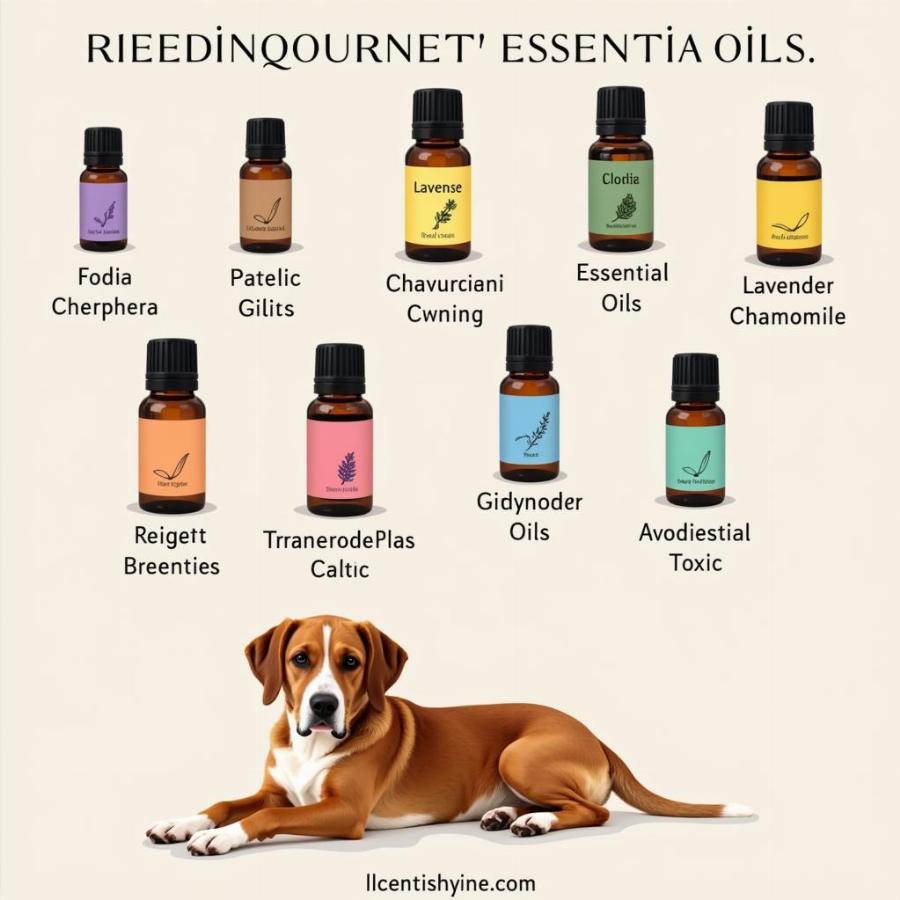Aromatherapy oils for dogs have become increasingly popular as pet owners seek natural ways to enhance their furry friends’ well-being. However, it’s crucial to understand that not all essential oils are safe for dogs. This comprehensive guide will delve into the world of aromatherapy for dogs, discussing the benefits, risks, and safe usage of essential oils. We’ll explore which oils are beneficial and which should be avoided entirely, empowering you to make informed decisions about incorporating aromatherapy into your dog’s care.
Understanding the Benefits and Risks of Aromatherapy Oils for Dogs
Essential oils are highly concentrated plant extracts that contain volatile aromatic compounds. While some oils can offer potential benefits for dogs, such as stress reduction and relief from certain skin conditions, others can be toxic and even life-threatening. It’s essential to consult with a veterinarian before using any essential oils on your dog. They can assess your dog’s individual needs and health status and advise on safe and effective usage.
 Essential Oils for Dogs
Essential Oils for Dogs
Safe and Effective Aromatherapy Oils for Dogs
Several essential oils are generally considered safe for dogs when used appropriately. Lavender oil, known for its calming properties, can help reduce anxiety and promote relaxation. Chamomile oil is another gentle option that can soothe skin irritations and aid in digestion. lemongrass oil safe for dogs can also be beneficial for repelling fleas and ticks. Always dilute these oils properly in a carrier oil, such as coconut or almond oil, before applying them to your dog.
How to Safely Use Aromatherapy Oils for Dogs
- Diffusion: Diffusing essential oils in a well-ventilated area is a safe way to introduce aromatherapy to your dog. Start with a low concentration and observe your dog’s reaction.
- Topical Application: Dilute essential oils in a carrier oil before applying them topically to your dog’s skin. Avoid sensitive areas like the eyes, nose, and mouth.
- Hydrosols: Hydrosols are a safer alternative to essential oils, as they are less concentrated. They can be used directly on your dog’s skin or fur.
Aromatherapy Oils to Avoid for Dogs
Certain essential oils are toxic to dogs and should be avoided entirely. These include tea tree oil, pennyroyal oil, wintergreen oil, and birch oil. These oils can cause severe liver damage, neurological problems, and even death. calming oils for dogs can be beneficial, but choosing the right ones is crucial. If you suspect your dog has been exposed to a toxic essential oil, seek immediate veterinary care.
Can I use aromatherapy to calm my dog?
Yes, certain aromatherapy oils, such as lavender and chamomile, can have calming effects on dogs. However, always use them cautiously and consult your veterinarian.
What are the signs of essential oil toxicity in dogs?
Signs of essential oil toxicity can include vomiting, diarrhea, tremors, difficulty breathing, and lethargy.
Are there any alternatives to essential oils for dogs?
Yes, hydrosols and dog-specific aromatherapy products are safer alternatives to essential oils.
How do I choose the right essential oils for my dog?
Consult with a holistic veterinarian who specializes in aromatherapy for dogs. They can assess your dog’s specific needs and recommend appropriate oils.
Conclusion
Aromatherapy oils for dogs can offer potential benefits when used responsibly and under the guidance of a veterinarian. By understanding the risks and benefits, and by choosing safe and effective oils, you can incorporate aromatherapy into your dog’s care regimen and enhance their overall well-being. smells that dogs hate can also be used strategically for training or deterring unwanted behaviors. Always prioritize your dog’s safety and consult with a professional before using any new products.
FAQ
- What if my dog ingests essential oils? Contact your veterinarian immediately.
- Can I use essential oils on puppies? It’s best to avoid using essential oils on puppies.
- Can I use essential oils around pregnant or nursing dogs? Consult your veterinarian before using essential oils around pregnant or nursing dogs.
- Where can I buy high-quality essential oils for my dog? Look for reputable brands that offer pure, therapeutic-grade essential oils.
- Can I make my own essential oil blends for my dog? It’s best to consult with a qualified aromatherapist or veterinarian before creating your own blends.
- How often can I use essential oils on my dog? Follow your veterinarian’s recommendations regarding frequency of use.
- Are there any breeds that are more sensitive to essential oils? Some breeds, such as those with brachycephalic (short-nosed) features, may be more sensitive to diffused oils.
Beaut Dogs is your trusted source for all things dog-related, providing comprehensive and expert advice on canine care. We offer a wealth of information on breed characteristics, health, nutrition, training, and much more. When you need support, please contact us via Email: [email protected] to receive detailed and accurate answers from Beaut Dogs. lemongrass for dogs offers a safe and natural way to repel pests.